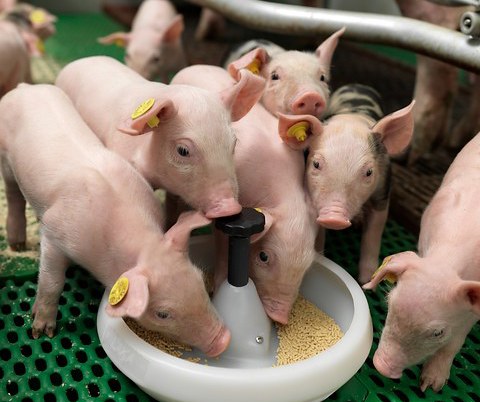The importance of creep feeding
As published in PORCUS - May 2016 Associated with weaning are marked changes to the histology and biochemistry of the small intestine, such as villous atrophy and crypt hyperplasia, which cause decreased digestive and absorptive capacity and contribute to post-weaning diarrhoea.

Special attention has to be paid to the role of food (energy) intake as a mediator of intestinal structure and function after weaning, although other influences, such as the source of protein added to the diet, may interact with food intake to alter gut structure and function. This is clearly an area of production concern, and future research into areas such as the manipulation of the immature digestive tract with exogenous growth factors and /or dietary supplementation with ‘non-essential’ amino acids such as glutamine, appear warranted.
Creep feeding is one way to smooth the transition at weaning with minimal performance checks. Creep feeding is the “art” of feeding a solid diet to piglets while they are suckling the sow, and thus preparing their digestive systems for weaning. This initiates and promotes gut and digestive enzyme development, which enables the piglet to digest nutrients from food sources other than that of milk. This encourages feed intake, which is one of the greatest challenges to post-weaning performance. Creep feeding becomes increasingly important and beneficial as weaning age increases. As piglets grow, their demand for nutrients grows and with increasing age this demand outstrips the capacity of the sow to supply them, as the sow’s milk yield peaks at around three weeks and then slowly declines. The same principle applies when one looks at infant foods like “Purity 1; 2; 3”.
Basics of good creep feeding
- Keep creep feed fresh and clean and out of reach of the sow
- Initiate exposure to creep at 3 to 5 days of age, or according to the manufacturer's recommendations
- Begin by offering creep on a flat surface, for example, a shallow tray (heavy metal or plastic trays that can hook into the slats)
- Place trays close to the piglets but not under direct heat as this will turn the feed stale too quickly; also, keep feed away from the dunging area
- Begin with very small amounts replaced at least twice a day, preferably more often. Always remove all uneaten creep; only un-medicated waste creep can be fed to the sow
- Offer creep when the sows are feeding as piglets are active and unlikely to be suckling for some time
- Do not overfeed - feed to appetite. This is where the “art” comes into play
- Introduce small troughs or top up the trays more often if litters are eating well
- Clean any fouled trays or troughs
- Store creep feed in a cool place and always close bags to prevent feed taking up the farrowing house odours and/or becoming rancid
- Commitment to creep feeding is more successful if more time and effort is devoted to it
- Remember the importance of the sow: it is crucial to maximise milk yield, she will be providing the majority of the piglet's nutrition; Creep helps the gut to develop and adapt to utilise solid feed and has a minimal influence on weaning weight
Improtance of creep feeding
- Proper creep feeding is a very valuable and worthwhile process but it must be done correctly to be beneficial
- Creep feed allows the piglet to become used to eating solid feed and makes the piglet familiar with what becomes the sole diet at weaning. Research has also shown that as creep feed intakes rise, post-weaning diarrhoea is reduce
- Supplementing sow milk with creep feed can result in both improved pre- and post-weaning performance, leading to an overall improvement in net return
- On average, you should expect a total creep feed intake of 500 g to 700 g per piglet when weaning at 26 to 28 days of age, although all units are different. Piglets weaned at 21 days will eat substantially less and those weaned later on will eat substantially more
- Whether you are achieving this intake or not (500 g to 700 g per piglet) make a note of current creep consumption and target an extra 100 g per piglet from what you are currently achieving
- Aim for a litter weaning weight of at least 90 kg piglet
References: www.wageningendadacemic.com, www.thepigsite.com/artides/4226/creep-feeding, Voluntary feed intake in pigs – David Torrrallardona & Eugene Roma – 2009, Auction for productivity pork.ahdb.org.uk/media/1987/action-creep-feeding.
